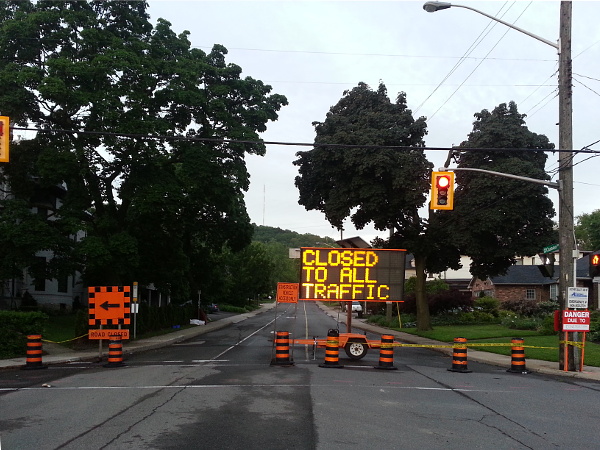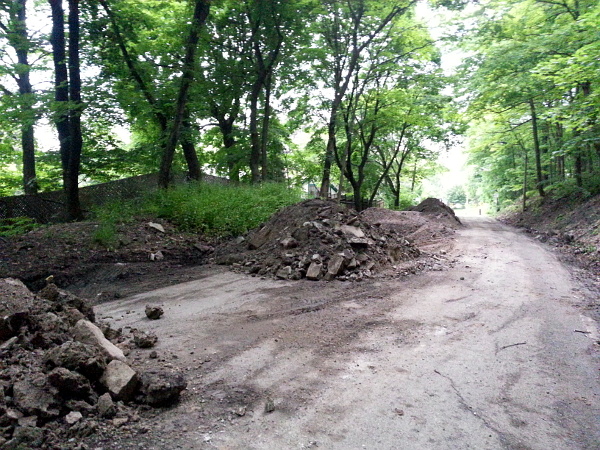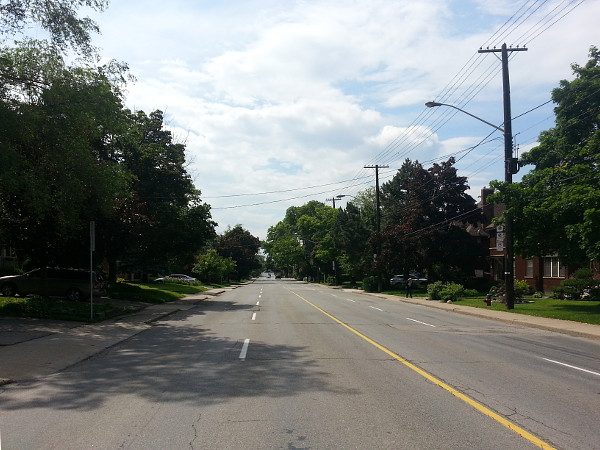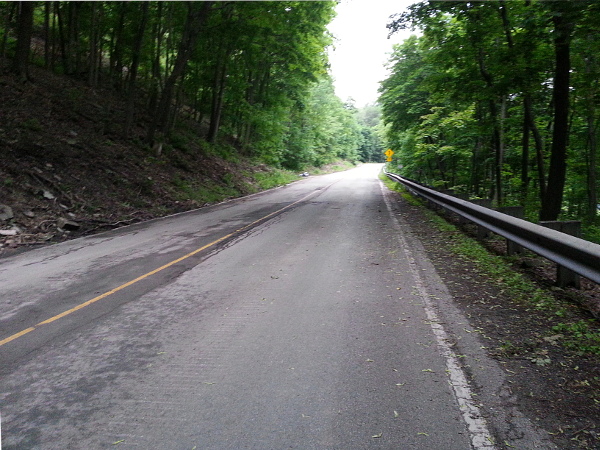The closure of Beckett Drive demonstrates just how pervasive through traffic normally is: loud, intimidating, dangerous and relentless.
By Ryan McGreal
Published June 14, 2013
The City has closed Beckett Drive for three months to strip down the many-times-patched escarpment access and rebuild it from scratch.
The access will be closed for the next three months. Large signs and barriers block the access on Queen Street at Aberdeen and on Garth Street at Fennell Avenue.

Queen Street south of Aberdeen is closed for the summer
Before the closure, City staff and commuters worried about what would happen to the approximately 21,000 cars that drove the access on an average day.
The good news, as anyone who understands how networks work could have told you, is that people quickly figured it out. Through some combination of shifting routes, shifting trip times and shifting trip destinations, all of the traffic has been accommodated.
According to Public Works spokesperson Kelly Anderson, the city isn't formally tracking traffic volumes but staff "have been out observing traffic conditions as a result of the closure. The only congestion appears to be on the West 5th access, as predicted." She concluded, "the impacts have essentially stabilized."
This squares with anecdotal comments from commuters who generally have generally reported at most a day or two of confusion followed by the discovery of alternate arrangements that work.
Of course, some streets have seen increased traffic. I've received a report from a resident on Herkimer that traffic volumes are up east of Queen as commuters navigate to the Jolley Cut and the West 5th.

Piles of rubble on Beckett Drive
Other streets have seen traffic volumes decline. I expected Aberdeen Avenue between Queen and Longwood would be quieter without the through traffic going between West Hamilton and the West Mountain.
What I didn't expect was that traffic volumes on Aberdeen would essentially collapse. I assumed there would be a noticeable reduction, but most of the traffic on Aberdeen has simply disappeared.
I had no idea just how much of the traffic running through Kirkendall on Aberdeen is cut-through traffic, passing through the neighbourhood from somewhere else to somewhere else. I certainly didn't think it was most of the total.

Aberdeen Avenue, late afternoon on a weekday, looking desolate
Another thing I didn't expect: I assumed it would be a bit quieter with the access closed, but I had no idea how more profoundly calm and peaceful the whole neighbourhood would become. It's almost spooky.
Living in the city, you quickly tune out the steady roar of automoible traffic that surrounds you. I had long since stopped noticing the steady wash of noise coming from both Aberdeen and Beckett until it ceased.
Because the drone of through traffic is gone, dogs in neighbouring yards can actually hear each other again. This has led to more back-and-forth canine communication chains, Twilight Bark style:
It's not surprising, then, that so many people in Kirkendall have expressed the wish that the access never re-opens to automobile traffic.
Tempted as I am by that prospect, I recognize that people need to be able to get around, and that our newfound neighbourhood tranquility comes at the cost of some inconvenience to others.
However, what this experience has already brought home to me in a deeply personal way is this: traffic is even more harmful than you think.
The harms that come from automobile traffic are well understood: stress, higher blood pressure, causes heart and lung disease, increased LDL cholesterol, and possibly even damage to cognitive ability.
We also know that through traffic is more dangerous to pedestrians than local traffic. As a study by McMaster University geography professor Niko Yiannakoulias recently demonstrated, neighbourhoods with more through traffic have higher rates of child injury in collisions.
At a deeper level, when you build a city for driving, more people will drive longer distances more often. The inverse is also true: when you build a city for walking, cycling and transit, more people will walk, cycle and take transit more often.
So we must add the opportunity cost of displaced walking and cycling trips to the bill: missed exercise, missed fresh air, missed stress relief - and missed peace and quiet.
In the short term, people can and do shift their transportation patterns in response to the choices available to them. As Swedish transport planner Jonas Eliasson demonstrated in a TED talk on congestion:
Travel patterns are much less stable than you think. Each day people make new decisions, and people change and the world changes around them, and each day, all of these decisions are sort of nudged ever so slightly away from rush hour car driving.
In the longer term, a city built around active transportation, the mixing of different uses (so destinations are closer together) and a de-emphasis on vehicle lane capacity as the solution to every problem is a city in which people start to make different choices not only about how to get from point A to point B but also about where to live, where to work, and how to structure their daily life.
The three-month closure of Beckett Drive is an opportunity for us to give that proposition some serious thought.

Beckett Drive, quiet at last
By Steve (registered) | Posted June 14, 2013 at 14:28:59
When will we put a stop to all these traffic snarling events!!! (sarcasm)
By Noted (anonymous) | Posted June 14, 2013 at 14:38:20 in reply to Comment 89545
http://www.wheels.ca/feature/can-smart-traffic-signals-ease-gridlock/2/
By Sara_M (anonymous) | Posted June 14, 2013 at 14:52:53
The learnings from the closure of the Queen Street Hill will be very helpful for the potential permanent closing of James Mountain Road to cars, so that it becomes an express route for transit and emergency vehicles.
Making James Mountain Road a transit priority mountain access was discussed at City Council when The Rapid Ready report was presented, and Terry Whitehead was in favour. There's no specific plan yet, but closing the Queen Hill shows that there is extra capacity and that closing James Mountain Road would not be a world ending move. The big resistance will be St. Joseph's hospital, since so many of their staff would find it very frustrating not to able to use James Mountain Road to drive directly between their two main sites.
By logonfire (registered) | Posted June 19, 2013 at 10:30:11 in reply to Comment 89549
Surely if the road were reserved for transit purposes, the staff should use the transit system!
By ScreamingViking (registered) | Posted June 14, 2013 at 15:44:12 in reply to Comment 89549
This is an interesting idea. Use the access for beefed up bus service between the upper and lower city, particularly once GO is running trains all day from James N.
True it would be twice the distance between the two hospital sites via the Jolley Cut or Beckett Dr., but how many trips would really be affected? If there's enough of them, why not run a shuttle that could use James? (same could be done for Mohawk if it ever puts programs in place downtown, something I'd love to see them do)
By Ted Mitchell (registered) | Posted June 15, 2013 at 22:38:51 in reply to Comment 89551
There are not two hospitals in Hamilton more unrelated than the two St Joes sites above and below James mtn road. Very few staff would need to travel between the sites.
By GrapeApe (registered) | Posted June 14, 2013 at 19:45:31
I have to admit I kind of like the change. The whole area feels more relaxed.
By Core-B (registered) | Posted June 15, 2013 at 07:58:46
I almost never cycle in the Kirkendall area. I have twice, since the closure, and must say that I really enjoyed it. I plan to take this opportunity to explore the area.
By Ted Mitchell (registered) | Posted June 15, 2013 at 22:57:07
The collapse of Aberdeen traffic is not that surprising, given the number of people who approach 80 on a 4 lane road with sidewalks immediately adjacent the roadway- you don't drive like that in your own neighbourhood.
Agreed it is disarmingly quiet when close to Beckett. It's like those houses just had $200,000 added to their value.
By TnT (registered) | Posted June 16, 2013 at 12:28:16
I must say a few weekends ago my wife and I strolled around Durand and Kirkendale and felt like entering a different world. The only vaguely "unsafe" strip was Charleton where drivers seemed to fly by above the speed limit.
By movedtohamilton (registered) | Posted June 17, 2013 at 08:31:38
Why not just permanently close Beckett Drive?
Comment edited by movedtohamilton on 2013-06-17 08:32:17
By Simmons (registered) | Posted June 17, 2013 at 13:23:29 in reply to Comment 89569
Beckett Drive is a heavily used roadway and is a valuable Mountain access for those from the West Mountain and Kirkendall/Durand; who use public transit and travel by car, alike.
Businesses, mostly small, and employers in both parts of the city rely on this road tremendously and I'm sure this three-month period will hurt those groups to some degree. These include but are not limited to Mohawk College, Chedoke Hospital, Hillfield, Upper Paradise, Locke St., Dundurn Ave. and Queen St. As well, some students use this access to travel to schools that offer French immersion (e.g. Westdale).
Think of Beckett less as a Mountain access, and more as a continuous street from one part of Hamilton to the next.
So, rather than arbitrarily closing a heavily used roadway and valuable mountain access, perhaps we need to look at calming traffic up/down the hill and along Aberdeen:
These are five measures that would provide enough disincentive for people looking for a quick commute. Plus the traffic lights along this road are adequately unsynchronized, unlike Main or King St.
Other than making Hamilton's most valuable properties more valuable, what benefit is there to closing this road?
Comment edited by Simmons on 2013-06-17 13:27:47
By Conrad664 (registered) | Posted June 18, 2013 at 12:32:49 in reply to Comment 89572
Oh as it go for stronger police service whould be nice on Main street from Dundurn to Gage
By kathy (registered) | Posted June 19, 2013 at 12:34:43
I have noticed that there is a huge traffic problem at Robinson and James. { related to the Queen St closure} Traffic using Robinson and attempting to turn left find it very difficult due to the long line of buses that all seem to arrive at that corner within minutes of each other.{ I counted five the other day} Perhaps they should forbid left turns at this intersection. Many seniors cross here and it is just a matter of time before one of them will be injured or worse. Traffic is a nightmare between the hours of 3pm to 7pm.
You must be logged in to comment.
There are no upcoming events right now.
Why not post one?